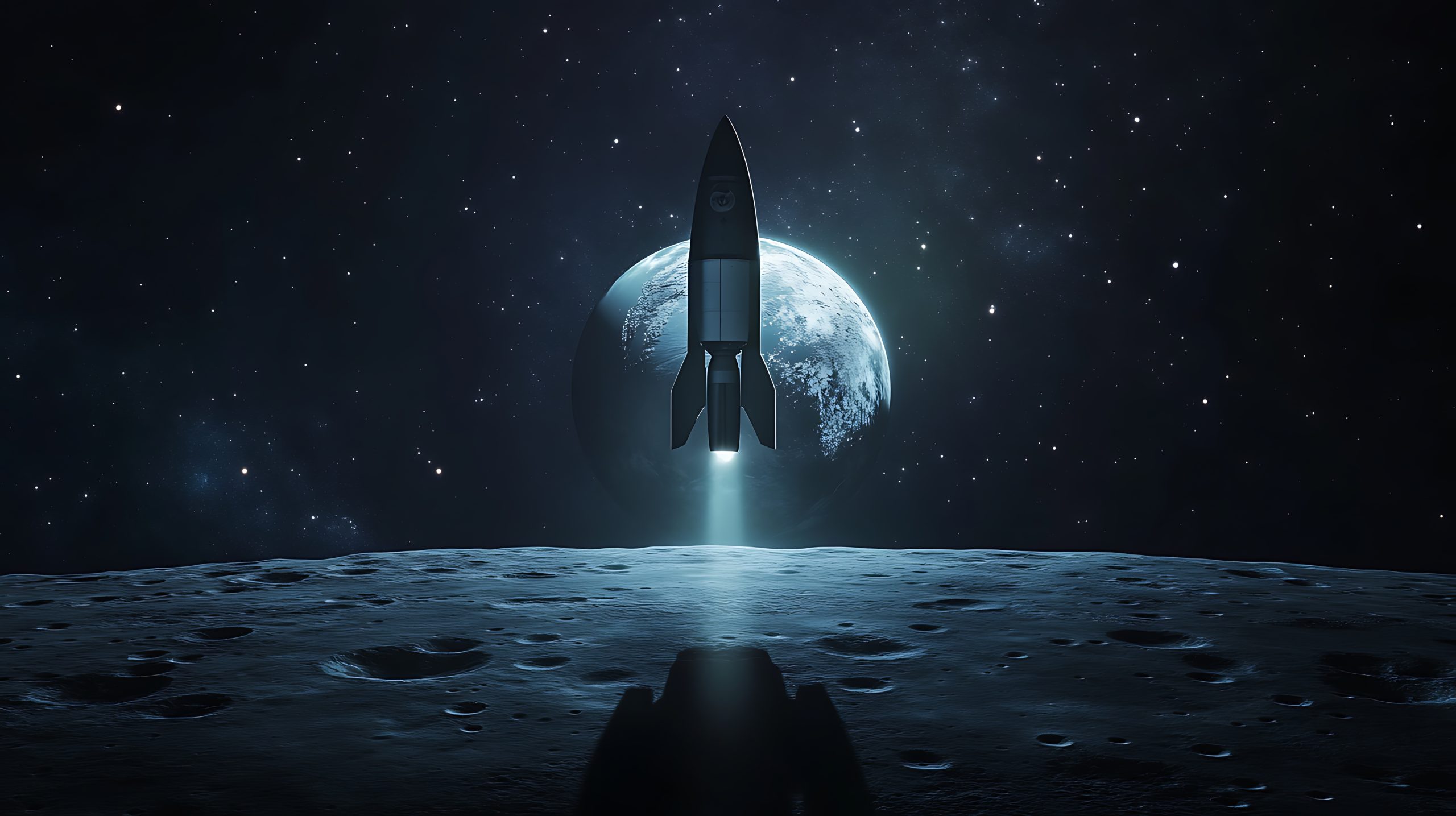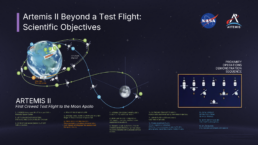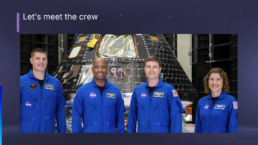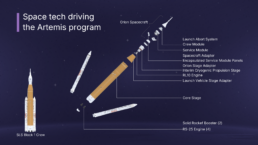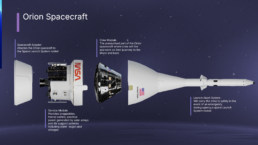Humanity is on the brink of a new space age, as after half a century NASA prepares to send astronauts around the moon. NASA’s Artemis mission is a significant step towards sustainable lunar exploration and the journey to Mars. As we count down to the historic launch of Artemis II in April 2026, here’s everything you need to know.
What is the Artemis program?
Artemis is the ambitious lunar project of the US’s space agency, NASA, that aims to return humans to the moon. This program wants to explore and create a long-term presence on the moon for:
Not just the Moon, Artemis also plays a critical role in preparing for the journey to Mars. The program’s name is derived from Artemis, the Greek goddess of the moon, and also represents the program’s goal of inclusion by landing the first woman on the moon and the first person of colour.
There are four phases to this program:
Artemis I – 2022 – uncrewed flight test around the moon successfully conducted
Artemis II – 2026 – crewed flight test
Artemis III – 2027 – Launch of first humans to the lunar south pole
Artemis IV – building the first lunar space station
Lunar Gateway
Along with building our presence on the moon, it also envisions building the Lunar Orbital Platform Gateway, humanity’s first space station in lunar orbit. Housing crews for one to three months, the Gateway will help with deep space experiments for a longer duration. It will be a multi-purpose outpost that will support surface missions on the moon, experiments in lunar orbit, and human exploration further into the cosmos. It will be carried into the lunar orbit by the first-of-its-kind mega moon rocket SLS and Orion spacecraft. In-situ resource utilization is another key aspect of space exploration and Artemis aims to utilize lunar resources like water ice in craters. It can be used for drinking, oxygen, and rocket fuel.
Breaking ground with Artemis I
The Artemis program was initiated with the successful launch of Artemis I in 2022 completing a 25.5-day lunar mission and traveling a total distance of 1.4 million miles. It was an uncrewed flight to test the safety of the Space Launch System (SLS) and the Orion spacecraft’s ability to reach the moon, perform in lunar orbit, and return successfully to Earth. The SLS rocket carried 10 cubesats, a type of nano-satellite, that will collect results to help monitor Earth, guide future projects, and protect astronauts. Artemis I is the first successful flight test for the world’s most powerful rocket, SLS, and is a step forward to the next stage of the program.
Artemis II Beyond a Test Flight: Scientific Objectives
Artemis II is the first crewed mission in the Artemis program involving a 10-day trip with four astronauts. Building on the success of Artemis I, Artemis II will carry humans farther from Earth than ever before, marking a momentous feat in humankind’s history.
While predominantly a test flight, the scientific objectives of Artemis II will help drive the success of future lunar missions.
Assessing human health in deep space: The mission will prove if Orion’s life support systems are prepared to sustain the astronauts on longer missions. This lunar flyby aims to evaluate the spacecraft’s systems and capabilities while carrying the crew in deep space.
Checking critical systems: The Artemis II mission will analyze Orion spacecraft’s navigation and communication systems to confirm they are ready for the trip to the Moon. It will also evaluate the fuel-efficient trajectory in which Orion will give the spacecraft the big push needed to break away from Earth’s orbit, setting it on an outbound trip to the far side of the Moon. For the return, the spacecraft will not need propulsion as it harnesses the Earth-Moon gravity field to pull Orion back naturally by Earth’s gravity for the free return portion of the mission.
Lunar Observation: Journeying approximately 4,600 miles beyond the far side of the Moon, this mission will provide a vantage point for critical lunar observation. Artemis II will be used to take images of the impact rays on the far side of the Moon which remains less explored. This information will be valuable in deciding landing sites for Artemis III.
Training: Artemis II will also test the viability of a new astronaut training program, NASA’s Lunar Fundamentals that will provide Artemis crew with a more comprehensive understanding of lunar geology.
Let’s meet the crew
NASA along with the Canadian Space Agency (CSA) has selected the four astronauts for the Artemis II mission. Commander Reid Wiseman, pilot Victor Glover, mission specialist Christina Koch from NASA, and mission specialist Jeremy Hansen from the Canadian Space Agency—will be the first humans in 50 years to fly close to the Moon’s vicinity.
Commander Reid Wiseman will be serving his second trip to space, as he had previously worked as the flight engineer on the International Station for Expedition 41 in 2014. For Glover and Koch too this will be the second space flight. By spending a total of 328 days in space Koch made the record for the longest single spaceflight by a woman. For Canada’s Hansen, a former fighter pilot, this will be his first flight to space.
Moon Playlist
NASA is creating a playlist for this mission. Some of the songs included are:
David Bowie: Space Oddity
Frank Sinatra: Fly Me to the Moon
Elton John: Rocket Man
Billie Holiday: Blue Moon
The Beatles: Across the Universe
Adele: Skyfall
Coldplay: A Sky Full of Stars
Duran Duran: New Moon on Monday
Katy Perry: E.T.
Foo Fighters: Learn to Fly
Ariana Grande: NASA
BTS: Mikrokosmos
Space tech driving the Artemis program
The Artemis program has deployed various innovative and cutting-edge technologies to bring this lunar dream to fruition.
Space Launch System rocket
The USA has built the world’s most capable and powerful rocket, Space Launch System (SLS). It is a super-heavy-lift rocket that provides the foundation for human exploration beyond Earth’s orbit. It is the only rocket that can catapult the Orion spacecraft into deep space along with astronauts and large cargo on a single mission. With its unprecedented power and capabilities, SLS is designed with various configurations that can be adjusted as per the mission requirements. Another unique feature of this flagship rocket is the reusability of some of its parts like the solid rocket boosters that are derived from the Space Shuttle program and are designed for recovery and refurbishment.
Orion Spacecraft
Orion will be the spacecraft that takes humans farther than they have ever been in space. This new generation spacecraft has been designed to carry humans to the moon and ultimately to Mars. In Artemis I, Orion has already traveled around the moon and surpassed the record for distance traveled by a spacecraft designed to carry humans, previously set during Apollo 13. Along with carrying the crew for deep space exploration, Orion also comes equipped with a Launch Abort System for emergency and life support for the crew. The crew module of the spacecraft is also designed as a reusable component, thereby reducing costs.
Lunar Terrain Vehicles
These are vehicles that astronauts will use to travel on the moon’s surface to conduct experiments, transport scientific equipment and collect samples from places that cannot be reached on foot. NASA has selected three private space companies to build these lunar rovers— Intuitive Machines, Lunar Outpost, and Venturi Astrolab. The LTVs need to withstand extreme conditions and feature advanced technologies like autonomous driving, among others.
Artemis Accord – Global space partnerships
It is a practical set of principles for international cooperation in space exploration initiated by the US in 2020 with seven other founding member nations— Australia, Canada, Italy, Japan, Luxembourg, the United Arab Emirates, and the United Kingdom. Based on the Outer Space Treaty of 1967, the Artemis Accord wants to focus on transparency, interoperability, and peaceful collaboration. It also aims to avoid conflicts in space, promote responsible and sustainable use of space resources, and encourage data sharing. To date, 39 countries have joined the accords.
Artemis fueling economic growth
Beyond a scientific achievement, the program also has long-term benefits for both the US and its international partners.
Job growth and revenue generation: The Artemis mission is expected to create job opportunities not only in direct areas like aerospace engineering but across multiple sectors. NASA’s Moon to Mars activities supported an estimated 96,479 jobs across the US and generated nearly $2.9 billion in tax revenue.
Building a lunar economy: One of the key focus areas of Artemis is the development of a lunar economy through utilizing lunar resources like helium-3, water ice, and others. This will not only help in sustaining a lunar presence but also pave the way for potential future industries in space.
Adoption of Tech Innovation: The technologies being developed for this program such as advanced materials, life support systems, and robotics will have far-reaching implications in other industries. For example, the synthetic biology technology that will be used to develop the food for space explorers could be used to develop long shelf-life foods, new and more sustainable techniques for creating medicines and plastics, and more. Such tech spin-offs can lead to new products, services, and improvements in fields like healthcare, energy, and manufacturing.
Beyond the Moon: Path to Mars
Artemis will lay the groundwork for Mars, the next leap in space travel. While the immediate goal of Artemis is to establish a lunar presence, the long-term mission is to send humans to Mars. As our close neighbor and one of the only other planets where life may have existed, Mars is a significant destination for scientific exploration. From understanding life support systems for longer duration travel to discovering successful ways to extract resources for fuel—the success of Artemis will play a significant role in driving the Mars missions. Understanding the Red Planet can help us decode our existence and even help create an alternate home for the future. Mars probe will help answer some of the fundamental questions of how life began and if there is life beyond Earth.
Upcoming Space Missions
- NASA launch of Europa Clipper, the first mission to conduct a detailed science investigation of Jupiter’s moon Europa.
- Japan Aerospace Exploration Agency’s (JAXA) Martian Moons eXploration (MMX), into orbit around Mars in 2027
- EnVision by European Space Agency (ESA), to investigate Venus
The Artemis program will herald the dawn of a new space era that will redefine how humans travel and explore not just the moon but the cosmos at large. This mission is not only bringing back the excitement of landing on the moon but also pushing the conversation by being more diverse and inclusive. This new era of exploration pushes boundaries, fosters global cooperation, and inspires future generations. Follow Artemis’ Twitter handle to keep track of the mission.
